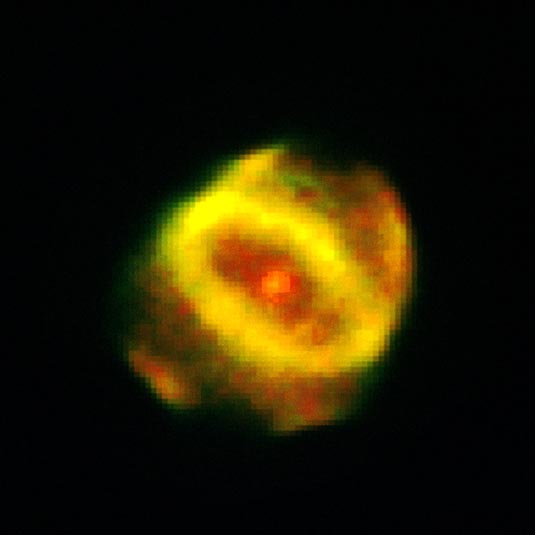
Planetary nebula
RA 17h 16m 21s Dec -59º 29m 23s
Ara
18,000 light years
August 1992
NASA, Matt Bobrowsky (CTA Inc)
January 5, 1993
1993 Image: N9302 1998 image: N9815 2016 Image: N1618
ABOUT THIS IMAGE:
This is a NASA Hubble Space Telescope picture of a recently-formed "planetary nebula," known as Hen 1357. This expanding cloud of gas was ejected from the aging star in the center. Much of the gas is concentrated in a ring which appears tilted 35 degrees. Besides the big clumps in the ring, HST's detailed images reveal many smaller clumps and wisps of gas, indicating turbulent motions and other activity in the nebula. Two bubbles of gas seen above and below the ring have burst open at their ends, allowing gas from inside to escape.
Previous ground-based spectroscopic observations show that, over the past few decades, Hen 1357 changed from looking like an ordinary hot star to an obiect with the characteristics of a young planetary nebula. Although the central star may have begun to expel gas as much as a few thousand years ago, only recently has there been enough radiation from the star to make the gas glow.
Before the Hubble observations, little was known about the nebula's structure because it is too small for anv detail to be seen using ground-based telescopes. Hen 1357 is about 18,000 light-years away and located in the southern constellation Ara the Altar. (The nebulae is so named because it is the 1357th object in a list of unusual stars compiled by astronomer Karl Henize.)
The term "planetary nebula" is a misnomer because these objects have nothing to do with planets - aside from vaguely resembling the extended disk of a planet. Planetary nebulae form when an aging star swells to become a "red giant" and it then blows off some of its outer atmosphere. As the nebula expands, the remaining core of the star gets hotter and heats the gas until it glows with the characteristic colors of a planetary nebula. A fast "wind" from the star compresses the gas and pushes the gas bubble outward. A ring-like structure forms if more gas is lost from the star's equator than its poles.
Hen 1357 is one of many young planetary nebulae which Bobrowsky is observing with HST. These observations will help astronomers understand how planetary nebula evolve in their early stages.
Technical Information: This color photograph is 5 composite of separate images taken at wavelengths of light emitted by two chemical elements in the nebula. The green and yellow light is emitted by oxygen and the red light by hydrogen. The images were made with HST's Wide Field/Planetary Camera (in Planetary Camera mode) during several days in August 1992